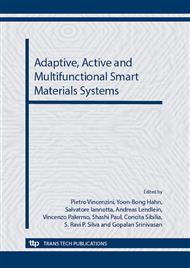[1]
H. Tobushi, K. Okumura, S. Hayashi, N. Ito, Thermomechanical constitutive model of shape memory polymer, Mech. Mater. 33 (2001) 545-554.
DOI: 10.1016/s0167-6636(01)00075-8
Google Scholar
[2]
G. Barot, I.J. Rao, K.R. Rajagopal, A thermodynamic framework for the modeling of crystallizable shape memory polymers, Int. J. Eng. Sci. 46 (2008) 325-351.
DOI: 10.1016/j.ijengsci.2007.11.008
Google Scholar
[3]
H.J. Qi, T.D. Nguyen, F. Castro, C.M. Yakacki, R. Shandas, Finite deformation thermo-mechanical behavior of thermally induced shape memory polymers, J. Mech. Phys. Solids 56 (2008) 1730-1751.
DOI: 10.1016/j.jmps.2007.12.002
Google Scholar
[4]
J.M. Husson, F. Dubois, N. Sauvat, A finite element model for shape memory behavior, Mech. Time-Depend. Mat. 15 (2011) 213–237.
DOI: 10.1007/s11043-011-9134-0
Google Scholar
[5]
M. Böl, S. Reese, Micromechanical modelling of shape memory polymers, Adv. Sci. Tech. 54 (2008) 137-142.
Google Scholar
[6]
Y. Liu, K. Gall, M.L. Dunn, A.R. Greenberg, J. Diani, Thermomechanics of shape memory polymers: Uniaxial experiments and constitutive modeling, Int. J. Plasticity 22 (2006) 279–313.
DOI: 10.1016/j.ijplas.2005.03.004
Google Scholar
[7]
H.A. Khonakdar, S.H. Jafari, S. Rasouli, J. Morshedian, H. Abedini, Investigation and modeling of temperature dependence recovery behavior of shape-memory crosslinked polyethylene, Macromol. Theor. Simul. 16 (2007) 43–52.
DOI: 10.1002/mats.200600041
Google Scholar
[8]
Z.D. Wang, D.F. Li, Z.Y. Xiong, R.N. Chang, Modeling thermomechanical behaviors of shape memory polymer, J. Appl. Polym. Sci. 113 (2009) 651–656.
DOI: 10.1002/app.29656
Google Scholar
[9]
A.S. Krausz and H. Eyring, Deformation Kinetics, Wiley-Interscience, New York, 1975.
Google Scholar
[10]
A. Ziabicki, Theoretical analysis of oriented and non isothermal crystallization I. Phenomenological considerations. Isothermal crystallization accompanied by simultaneous orientation or disorientation, Colloid Polym. Sci. 252 (1974) 207-221.
DOI: 10.1007/bf01638101
Google Scholar
[11]
L.R.G. Treloar, The Physics of Rubber Elasticity, Oxford University Press, Oxford, 1975.
Google Scholar
[12]
G. Heinrich, E. Straube, G. Helmis, Zur Theorie der Konfigurationsbehinderungen in polymeren Netzwerken II. Spannungs-Deformations-Verhalten Kautschukelastischer Netzwerke, Plaste Kautsch. 26 (1979) 561-562.
DOI: 10.1515/zpch-1979-0197
Google Scholar
[13]
T. Ozawa, Kinetics of non-isothermal crystallization, Polymer 12 (1971) 150-158.
DOI: 10.1016/0032-3861(71)90041-3
Google Scholar
[14]
I.S. Kolesov, H.-J. Radusch, Multiple shape-memory behavior and thermal-mechanical properties of peroxide cross-linked blends of linear and short-chain branched polyethylenes, Express Polym. Lett. 7 (2008) 461–473.
DOI: 10.3144/expresspolymlett.2008.56
Google Scholar
[15]
I.S. Kolesov, K. Kratz, A. Lendlein, H.-J. Radusch, Kinetics and dynamics of thermally-induced shape-memory behavior of crosslinked short-chain branched polyethylenes, Polymer (50) 2009 5490–5498.
DOI: 10.1016/j.polymer.2009.09.062
Google Scholar
[16]
I. Kolesov, O. Dolynchuk, H.-J. Radusch, Simulation and experimental investigation of shape-memory recovery of polyethylenes with different degree of branching and crosslink density, in: CD Proceedings of 14th International Conference Polymeric Materials, Halle (Saale), 2010.
Google Scholar


